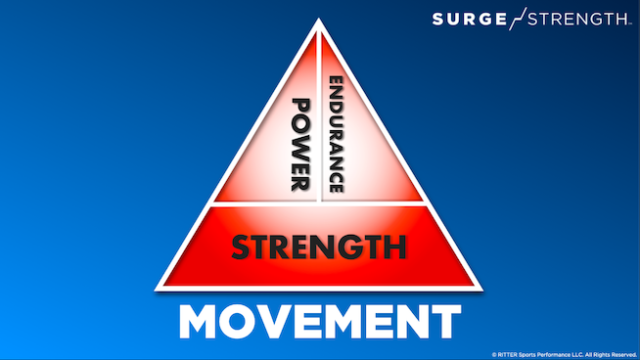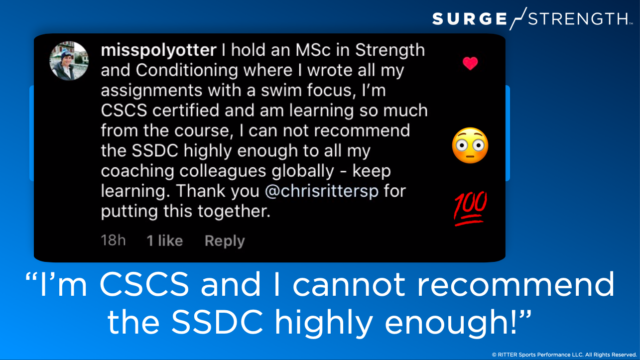Trying to pull off a swimming taper dryland plan in the 2020-2021 swim season is a challenge like no other. What we’re seeing is that thankfully, most teams are going to be able to have end of season meets. Those that can’t are coming up with creative ways to showcase their swimmers, such as with virtual time trials. Because of this, the one-size-fits-all taper approach of the past will not work. Swim coaches need a taper plan that matches their unique swim season scenario.
SURGE Strength is here to help coaches end this swim season on a high note. Our team has put together a roadmap to lead swimmers towards the best times that they so deserve after a tumultuous and perhaps stressful season. By applying the principles unpacked in this article, coaches will increase their team’s potential as they dive into the pool one last time.
The Importance of Swimming Taper Dryland Interaction
You may think that towards the end of a season, most of the time that you have coaching your swimmers should occur in the pool. But, this is a common myth. Even during a swimming taper, dryland will play an important role. Some teams have even relied solely on dryland this year, as getting in the water was not always possible or safe.
SURGE Strength recommends that Dryland be incorporated right up to the championship meet. This is because Dryland primes the central nervous system (CNS), and maintains your athletes’ strength as they get “tired” before taper. Dryland is also a great injury prevention tool. Research shows that swimmers who incorporate prehab, or preventative exercises, specifically for the shoulder, are less likely to suffer injury than swimmers who don’t. An appropriate dryland program is your secret weapon to ending a swim season strong, especially when consistency in the water isn’t possible for your team’s specific situation.
Swimming Taper Dryland Keys to Success
Dryland follows a similar method of tapering that we see in the pool. Yardage comes down with short bouts of intensity kept in in order to prime the muscles and keep the athletes in good shape.
Training volume of dryland sets should decrease to 25% of the current exercise prescription. For example, if your swimmers are completing up to 4 sets of an exercise, they should gradually taper down to 1 set of the exercises during taper. Keep in mind that exercises should be completed with the same load and effort as before. This keeps the CNS firing and the body strong, which is crucial to the “pop” a swimmer feels during a well-tapered race. This is oftentimes what coaches miss, as we see instances where teams completely stop their usual dryland routine. Instead of decreasing volume load to 25%, swimmers end up with 0% of the dryland load that they experienced before. This has the opposite effect that we are striving for in taper and is the equivalent of giving swimmers a week or two off from practice right before championship meets.
Keep in mind that decreasing to 25% of volume load will look different for every swimmer. Below, we discuss how to individualize dryland during taper to better match your team’s training age:
Tailoring Dryland Taper to Your Team’s Needs
There are many ways to phase out dryland at the end of a swim season. The best approach depends on two factors: what you have been doing up until this point and your swimmer’s dryland training age.
Training Power
Ideally, working through a power phase is the best approach to the dryland taper. Power is defined as force production over a given period. To train power, think of explosive exercises such as jumps. Other examples include exercise circuits with a slam ball. Advanced athletes may even incorporate some Olympic lifts into this phase. These exercises prime the CNS to react quickly to a stimulus (think jumping off the block at the start of a race). In addition, they help athletes recruit muscle faster and more efficiently in a race. Setting up your season plan to emphasize power through taper is the best way to peak at the end of the season. Therefore, athletes should lead into this phase with a solid base of strength.
Training Strength
Strength is a prerequisite to power. Therefore, athletes must be strong in order to be explosive. Incorporating strength phases over the course of the season sets the athletes up for a successful power phase during taper. If you have been training strictly power exercises for a while leading up to the end of season, we recommend swapping it out for a strength phase or even a strength-power phase with reduced volume before your championship meet.
This recommendation is because the body needs new stimuli in order to change and adapt. It is important to activate key movements even during recovery periods. On the other side of the spectrum however, swimmers should not be breaking down a ton of muscle. Find the sweet spot of just a few strength or strength-power exercises during taper at high intensities. This is crucial for swimmers to maintain the muscle they have worked hard to build throughout the season.

During a Swimming Taper Dryland Don’t Keep Changing Phases
How often swimmers need that change in stimulus depends highly on their training age. Training age is defined as how long the swimmers have been participating in a consistent dryland program. We recommend that beginners (swimmers with less than 6 months to a year of resistance training experience) should work through 4 weeks of strength, 3 weeks of strength-power, and 1 week of power leading up to their championship meet.

If you are working with athletes who have over a year of resistance training experience, we recommend spending two weeks in each of the 3 phases listed above prior to their big meet.

There are other factors that go into this periodization process. Some athletes do better with a strength-power phase during taper. Others thrive off strictly training power. Hear about some other factors that go into this from Chris below:
Reassessing Your Dryland Plan
If you have not thought about cycling through strength and power throughout the season, don’t worry, all is not lost. Just remember that athletes need constant stimulus in order to change and grow. Look back at what you have been doing up until this point and adjust your plan to match this method. Most importantly, you want your athletes moving explosively with maximal effort during taper. Combine this principle with making sure they have a full recovery between exercise bouts, and you’re on your way to a successful dryland taper.
What About a Double Taper?
Dryland is a great tool to keep the momentum going strong between big meets. Some swimmers find themselves “tapering” for up to 6 weeks by the time they qualify for their “biggest” meet of the season. As a swim coach, you know that you can’t just “rest” through this crucial time period. The same goes for dryland.
We suggest spending 1-2 weeks after the first tapered meet in a strength phase. Focusing on strength changes the stimulus and helps the body recover. This is especially true if they just spent a couple weeks in a power phase. From here, gradually build up intensity and volume as the swimmer recovers. Keep in mind that you still should not reach peak volume during this period.
However, you should build to peak intensity. For example, the week after a big meet, start with 1 set of exercises. The swimmer may feel fatigued. Therefore, what is normally a sub-maximal effort may feel like an all-out effort during this week. As the swimmer recovers from the meet, build the volume back up to 2 or 3 sets depending on how many weeks are between meets. Coach the swimmer to continue giving all-out effort. Then, be sure to provide them with full recovery periods between sets. As the next meet approaches, reintroduce a little strength-power back into the program directly before the next competition. This leaves your swimmer’s CNS feeling refreshed and ready to perform.
Coaching dryland through the end of a season doesn’t have to be tricky or complicated. It simply requires coaches to look back at their season and reassess what their swimmers really need. The worst way (and the most common way) to approach this is by telling your swimmers to simply stretch and stop training strength and power. A better way is to cycle through these 3 crucial phases: strength, strength-power, and power. The science shows that dryland improves performance when implemented properly. It does not break a taper; in fact, it makes the taper.
With championship meets being rescheduled, postponed, and canceled, this method of cycling through periodized dryland phases is the best way coaches can serve their swimmers through this season. Rather than setting an inflexible date to start or stop dryland, try this more flexible approach. You will learn which variation works best for you as a coach and for the current athletes on your team. No matter what your swimming taper dryland can help you have a better result.
NEW – AT HOME DRYLAND WORKOUT
GET IT FOR FREE BY ENROLLING IN THE SURGE STRENGTH ACADEMY
JOIN OTHERS FROM AROUND THE WORLD THAT ARE
BECOMING SURGE STRENGTH DRYLAND CERTIFIED (SSDC)

BECOME SURGE STRENGTH DRYLAND CERTIFIED (SSDC)
BUILD BETTER ATHLETES TO GENERATE FASTER SWIMMERS
Courtesy of SwimSwam’s exclusive dryland training partner, SURGE Strength.
SURGE Strength, a strength training brand created by Chris Ritter, CEO of RITTER Sports Performance, aims to build better athletes and faster swimmers through dryland programs, and coaching education.







